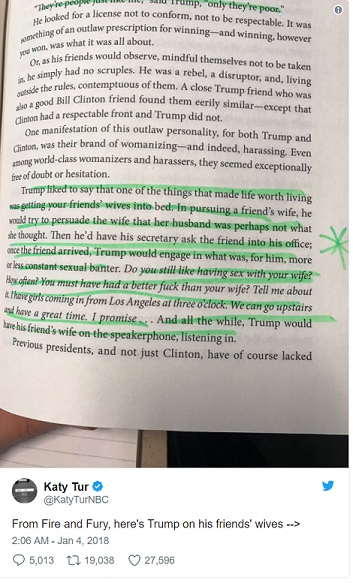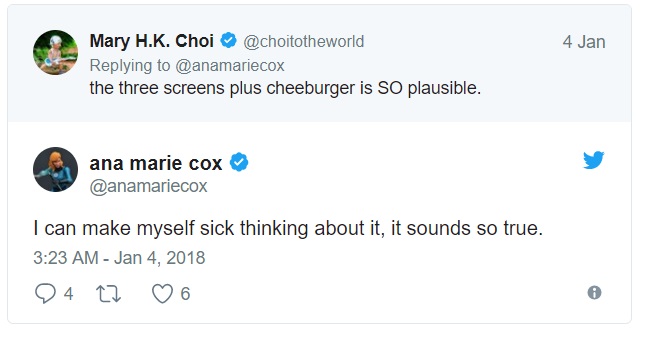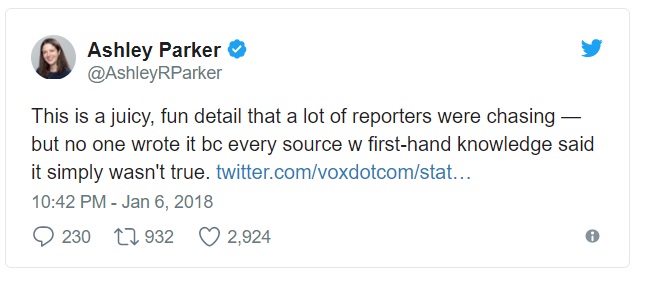Home > Media News >

Source: https://www.buzzfeed.com
By Charlie Warzel
The Trump tell-all is an incendiary piece of factually debatable content that’s perfectly engineered for virality and, depending on your side, a confirmation of every politically motivated suspicion.
Fire and Fury, the controversial Trump White House tell-all by Michael Wolff, may very well be the first book to achieve best-seller status by virtue of viral Twitter screenshot.
Since the moment the first quotes from the book leaked online via the Guardian, social media has been flooded by big blocks of Wolff’s prose, excerpted from advance copies of the book and magazine excerpts. For days now, the hunks of text, each one a different incendiary quote or observation from the tome, have been screenshot and breathlessly shared by journalists, pundits, and activists on either side of the aisle.

The result is a political Rorschach test of sorts. For those on the left, Wolff’s observations are vindication: reported proof of any number of long-suspected but unproven theories. Bannon thinks talks with Russia were treasonous! The president’s own staff think he’s mentally unstable! Trump never wanted to be president! His wife hates him! The commander in chief spends his evenings eating cheeseburgers in bed and screaming at the television! Similarly, Trump’s most ardent online defenders have taken to sharing chunks of the book in an effort to discredit its claims. Liberal fanfiction! Of course the president knows who John Boehner is! What about Hillary's health?!
Adding to the drama are questions of the author himself, a controversial media gadfly with a dubious reputation that includes allegations as to whether his reporting can be trusted. Errors spotted by journalists and pundits of all political persuasions have already cast doubt on what’s true in Fire and Fury and what has been inferred or even imagined by Wolff cobbling together unconfirmed anecdotes and rumored speculation.

All of which makes Wolff’s book the perfect chronicle for 2018’s fractured and toxic media ecosystem. More than that, Fire and Fury is, in many ways, the first real book of the post-truth hyperpartisan social media era: an incendiary piece of factually debatable content that’s perfectly engineered for virality and, depending on your side, a confirmation of every politically motivated suspicion.
The most obvious online comparison for Wolff’s book might be hyperpartisan Facebook pages, which became infamous during and after the 2016 election for, as the New York Times’ John Herrman wrote, “cherry-picking and reconstituting the most effective tactics and tropes from activism, advocacy and journalism into a potent new mixture.” Like these pages, which are painstakingly optimized to appeal to partisan emotions (and share widely), Fire and Furyblends honest reporting — real access and real quotes — with gossip, rumor, and, most important, a feeling: a bone-deep suspicion fueled by endless reporting and coverage whose confirmation is often just out of reach. Some of the screenshots are even reminiscent of 2016's more conspiratorial posts (if you're eagerly tweeting screenshots and claiming with certainty that Trump has dementia, are you that different from your uncle sharing fake Facebook news of a Clinton health crisis?). To those who’ve long suspected the Trump White House is even more dysfunctional than has been reported, Wolff’s book does more than just scratch the itch — it’s not just true, it’s truer than true.
You can see this on Twitter, where journalists are grasping publicly with Wolff’s reporting and trying to make sense of what to believe. Earlier this week political columnist Ana Marie Cox mused, “My guess about accuracy of Wolff’s book: It’s based on *something.* I believe with my whole heart Trump is in bed by 6:30, randomly calling people he thinks are his friends and gossiping about other people he thinks are his friends. They are the sources. They are not his friends.” Similarly, in a subsequent thread, Cox and writer Mary H.K. Choi grappled with the central issue of the contested claims in the book: their total plausibility. “The three screens plus cheeburger is SO plausible,” Choi tweeted. To which Cox replied, “I can make myself sick thinking about it, it sounds so true.”

To anyone following — and trusting — the palace intrigue reporting coming from the White House in 2017, the book sounds so true. Like a good post from a hyperpartisan Facebook page or a viral Twitter pundit, Fire and Fury gives just enough credible evidence to support some of its astonishing claims before moving into the territory of wishful thinking; it muddies the waters just enough to make them virtually impossible to debunk or fact-check. As the Times’ Maggie Haberman — whose reporting from inside Trump’s inner circle has helped add plausibility to even the most salacious claims in Wolff’s book — remarked on Twitter, “even if some things are inaccurate/flat-out false, there’s enough notionally accurate that people have difficulty knocking it down.”

Thanks to a deeply fractured media environment in which pro- and anti-Trumpers each live in parallel universes of information, Fire and Fury works on all the same levels for the far right. Just as the book fulfills many a liberal fantasy about the Trump administration, its publication is in many ways a justification of the pro-Trump media’s long-standing criticisms of the mainstream media. While the left got the reporting it craved, the right got what seemed to them like confirmation that mainstream reporting is biased, deceitfully obtained, salacious, and loose with the truth but hidden behind the veneer of rigorous reporting. Previous claims — from mainstream media outlets, no less — that Wolff “acknowledges that conventional reporting isn’t his bag” are bandied about on Twitter as proof that the author has no scruples. Sloppy factual errors are pointed out in support of the argument that none of the book’s claims can be trusted. Trump acolytes mentioned in the book have claimed — in viral tweets of their own — that the book is so much more fake news — I was there; it didn't happen that way. Each denial becomes its own viral piece of evidence of a corrupt and reckless mainstream media.
Since portions of it first began appearing online, Fire and Fury has sucked all the air out of a very mercurial news cycle. In a matter of days, it's prompted extensive discussion across all possible media; it's caused the president to viciously disavow his former chief strategist and call for the book to be banned; it's reignited a new narrative around Trump’s mental health and its effects on his presidency. And yet, despite all the upheaval, nobody seems any closer to knowing what in the book is true and what’s not. But that’s not stopping anyone from sharing its revelations.
Which is why Fire and Fury might be the perfect chronicle for not just the Trump era, but the social media era entire. For Wolff’s book, the truth seems almost a secondary concern to what really matters: engagement. In a hyperpartisan online age, Wolff seems to have understood for years what the Facebook’s hyperpartisan page operators found out in 2016. “The point,” Herrman wrote about those pages for the Times, “is not to get them to click on more stories or to engage further with a brand. The point is to get them to share the post that’s right in front of them. Everything else is secondary."
Now, in the post-truth Facebook era, it appears the same can be true for books like Wolff’s as well. On Wednesday — as the leaked excerpts rolled out across the internet — Fire and Furywent from No. 48,449 on Amazon's best-selling books list to No. 1.
Right Now

18 Jul, 2025 / 09:39 AM
Uber to invest 300 million-dollar in EV maker Lucid as part of robotaxi deal

21 Jul, 2025 / 08:40 AM
Google’s AI can now call local businesses to check prices and availability on your behalf
Top Stories








